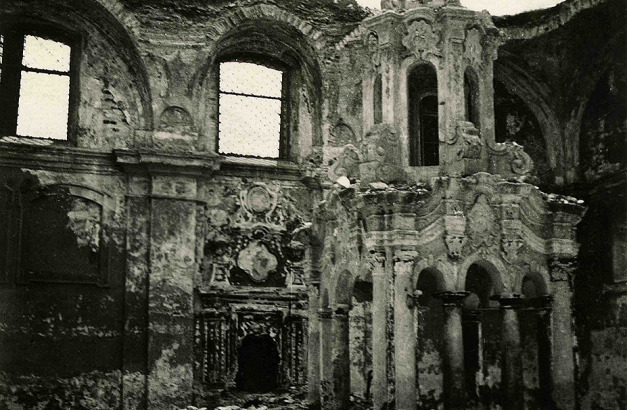Liudyti ir įamžinti: Įamžinti griuvėsius buvo mano tikslas. Aš žvelgiau į juos kaip į istorinius ir etnografinius dokumentus. Dieną ir naktį klajojau po griuvėsius ir padariau šimtus eskizų, kad vėliau juos panaudočiau. (Rafaelis Chvolesas)
Chvolesas į gimtąjį Vilnių sugrįžo 1945 metais. Antrąjį pasaulinį karą išgyveno dvi dailininko seserys – Sofija ir Rivka, jo pažinotas Vilnius buvo virtęs griuvėsiais, draugai išžudyti, tėvų namai sugriauti. Ypač nukentėjo buvę žydų gyvenamieji kvartalai ir dvasinis centras Didžioji sinagoga. Dailininkas daugiau nei dvejus metus (1945–1947) piešė, eskizavo, tapė ir fotografavo tai, kas liko iš buvusio miesto, – jautė pareigą viską užfiksuoti. Taip gimė reikšminga paveikslų serija Vilniaus getas. Nostalgiški prarasto žydiško Vilniaus vaizdai neatitiko stalinistinės cenzūros nustatytų „šviesaus socrealizmo“ temų, pokario metais R. Chvoleso kūrybą vertino tik kiti dailininkai. Norėdamas turėti oficialų dailininko statusą ir dalyvauti parodose, 1946 m. jis įstojo į LSSR dailininkų sąjungą, o 1951 m. – į SSRS dailininkų sąjungą, sukūrė industrinio realizmo stiliaus peizažų. Tuo pačiu metu vien sau tapė šeimos narių ar draugų portretus, religinius siužetus. Dailininkas su šeima gyveno nepritekliuje, jautėsi nepripažintas menininkas. Tai nulėmė jo apsisprendimą 1959 m. pasinaudoti paskutine sovietinės valdžios buvusiems Lenkijos piliečiams suteikta galimybe pasitraukti į Lenkiją.
Rafaelis Chvolesas
To witness and immortalize: To immortalize the ruins was my goal. I looked at them as historical and ethnographic documents. I wandered around the ruins day and night and made hundreds of sketches for later use. (Rafael Chwoles)
Rafael Chwoles returned to his native Vilnius in 1945. The artist’s two sisters, Sofia and Rivka, survived the war. However, the Vilnius he knew was turned into ruins, his friends were killed, and his parents’ house was destroyed. The former Jewish residential quarters and the spiritual center, the Great Synagogue, were particularly damaged. For more than two years (1945–1947), Chwoles drew, sketched, painted and photographed what was left of the former city. He felt the obligation to capture everything. This is how the significant series of paintings Vilna Ghetto was born. Nostalgic images of the lost Jewish Vilna did not correspond to the themes of “bright socialist realism” established by Stalinist censorship. In the post-war period, Chwoles’ work was appreciated only by other artists. In order to have the official status of an artist and participate in exhibitions, in 1946, Rafael Chwoles joined the Artists’ Union of the LSSR, and in 1951, the Artists’ Union of the USSR. He created landscapes in the style of industrial realism. At the same time, in private, he painted portraits of family members or friends, and religious scenes. The artist and his family lived in poverty. As the artist, Chwoles felt unappreciated. This determined his decision made in 1959 to take advantage of the last opportunity given by the Soviet authorities to former Polish citizens to leave for Poland.
